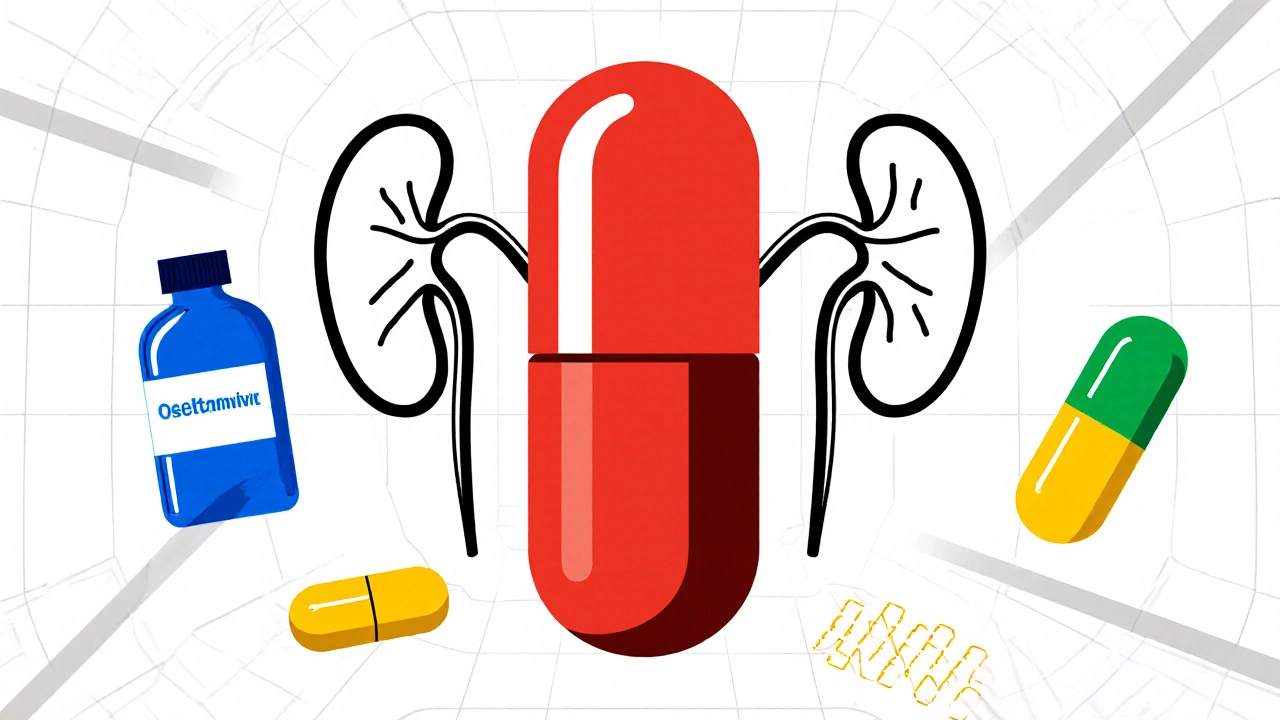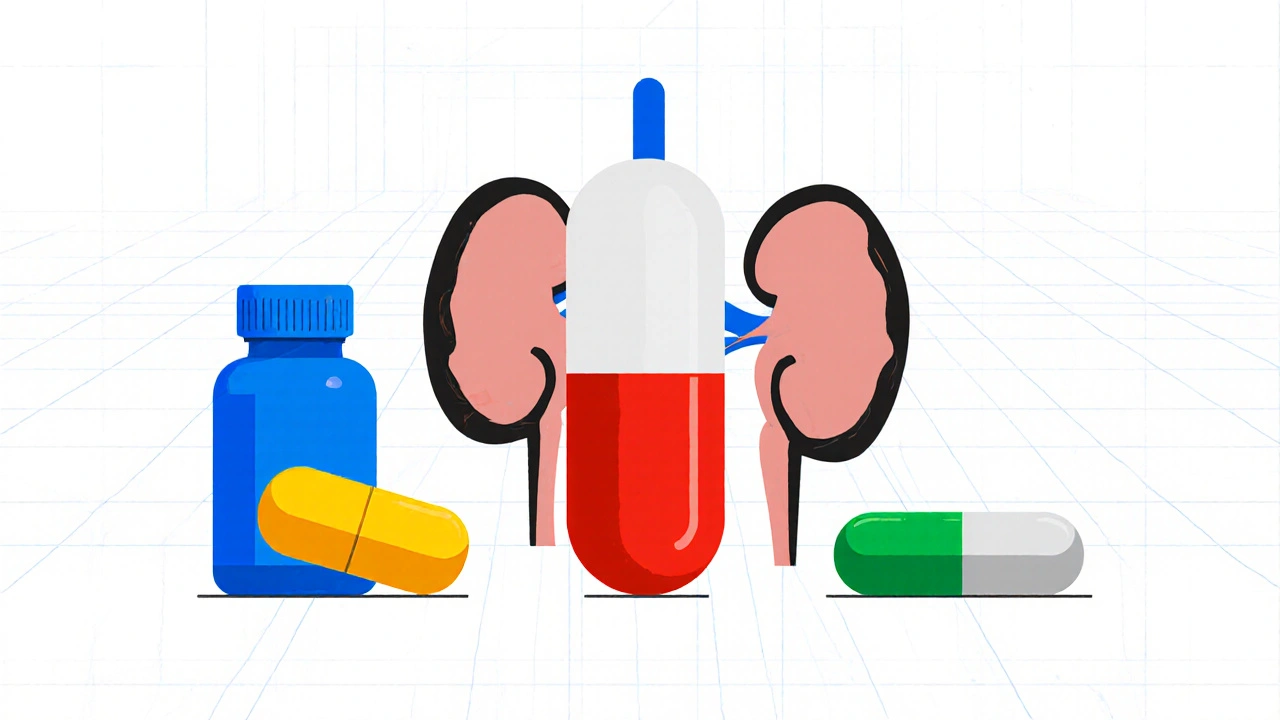Oseltamivir Interaction Guide: What to Know About Other Medications
 Oct, 25 2025
Oct, 25 2025
Why drug interactions matter with Oseltamivir
When taking Oseltamivir a neuraminidase inhibitor used to treat and prevent influenza, it’s easy to assume it works in isolation. In reality the drug travels through the same metabolic pathways as many prescription and over‑the‑counter (OTC) medicines, so a surprise reaction can turn a short flu course into a hospital visit. This guide walks you through the most common interactions, explains the science behind them, and gives practical steps to stay safe.
How Oseltamivir works - a quick science check
Oseltamivir (brand name Tamiflu) blocks the influenza virus’s neuraminidase enzyme, preventing new viral particles from leaving infected cells. The drug is a pro‑drug: after oral intake it’s converted in the liver to the active metabolite oseltamivir carboxylate. This conversion uses hepatic esterases, not the cytochrome P450 (CYP) system, which means most CYP‑mediated interactions are mild. However, Oseltamivir is excreted unchanged by the kidneys, so any agent that affects renal clearance can change its blood levels.
Medications that can raise Oseltamivir levels
Anything that slows kidney function or competes for tubular secretion can cause the active form to accumulate. The most clinically relevant culprits are:
- Ranitidine - an H2‑blocker that can reduce renal clearance of oseltamivir.
- Probenecid - used for gout, it blocks organic anion transporters, raising oseltamivir concentrations.
- Cimetidine - another H2‑antagonist with a similar effect.
Patients on these drugs may experience higher than intended exposure, which can increase the risk of nausea, vomiting, and, in rare cases, neuropsychiatric events.

Medications that can lower Oseltamivir effectiveness
Because Oseltamivir bypasses CYP enzymes, classic enzyme inducers have a limited effect. Still, drugs that speed up renal excretion can lower drug levels:
- Sodium bicarbonate - high‑dose IV therapy can increase urine alkalinization, speeding removal of the active metabolite.
- Loop diuretics such as furosemide, which boost urine output and may reduce plasma concentrations when used aggressively.
In practice these effects are modest, but clinicians should watch for treatment failure in patients receiving high‑dose diuretics.
Bleeding‑risk drugs + Oseltamivir: a double‑edged sword
Oseltamivir itself isn’t an anticoagulant, but flu symptoms (fever, dehydration) can predispose patients to clotting issues. Adding a blood thinner can tip the balance toward bleeding:
| Drug | Interaction type | Potential clinical effect | Management tip |
|---|---|---|---|
| Warfarin | Pharmacodynamic | Increased INR, higher bleeding risk | Monitor INR closely; adjust warfarin dose if needed |
| Aspirin | Additive antiplatelet effect | Gastrointestinal bleeding, especially in elderly | Use lowest effective aspirin dose; consider gastro‑protection |
| Clopidogrel | Synergistic platelet inhibition | Bleeding from minor injuries can become severe | Assess bleeding history; monitor hemoglobin if combined therapy is unavoidable |
When any of these agents are part of a patient’s regimen, clinicians should check baseline coagulation parameters and re‑assess after starting Oseltamivir.
Neuropsychiatric concerns and serotonergic drugs
Reports from Japan linked Oseltamivir to rare neuropsychiatric events, especially in children and adolescents. While the mechanism isn’t fully clear, combining the drug with serotonergic agents may amplify risk:
- Selective serotonin reuptake inhibitors (SSRIs) such as fluoxetine or sertraline.
- Tricyclic antidepressants (TCAs) like amitriptyline.
- St. John’s wort - an herbal product that influences serotonin pathways.
If a patient reports agitation, hallucinations, or sudden mood swings while on Oseltamivir, consider a drug‑induced serotonin syndrome and seek immediate medical evaluation.
Special populations: renal impairment, pregnancy, and the elderly
Because Oseltamivir is cleared unchanged by the kidneys, dose adjustments are needed for chronic kidney disease (CKD) stages 3‑5. The usual adult dose (75 mg twice daily) should be reduced to 75 mg once daily for creatinine clearance 30‑50 mL/min, and to 30 mg twice daily for clearance below 30 mL/min.
Pregnant women can use Oseltamivir safely; studies show no increase in congenital anomalies. However, because pregnancy itself raises clotting risk, clinicians should be extra cautious when prescribing aspirin or low‑molecular‑weight heparin alongside the antiviral.
Older adults often take multiple prescriptions, so polypharmacy is a red flag. A simple medication reconciliation checklist can catch hidden interactions before they cause trouble.
Practical checklist for clinicians and patients
- Review the patient’s current medication list, focusing on renal‑clearance agents (e.g., Ranitidine), anticoagulants, and serotonergic drugs.
- Assess renal function (eGFR or creatinine clearance). Adjust Oseltamivir dose if eGFR < 50 mL/min.
- Ask about OTC use-aspirin, ibuprofen, herbal supplements (especially St. John’s wort).
- If a bleeding‑risk drug is present, arrange baseline labs (INR, platelet count) and set a monitoring plan.
- Educate patients on warning signs: severe nausea, vomiting, confusion, unusual mood changes, or any signs of bleeding.
- Document any dose adjustments or monitoring steps in the patient’s chart for continuity of care.
Following these steps reduces the chance of an unexpected adverse event and keeps the flu treatment on track.

Real‑world case examples
Case 1 - Elderly patient on warfarin: Mrs. L, 78, was prescribed Oseltamivir for a confirmed H1N1 infection. She was already on warfarin for atrial fibrillation with a stable INR of 2.5. After starting Oseltamivir, her INR spiked to 3.8, and she developed a small sub‑galeal hematoma. The clinician reduced the warfarin dose by 10 % and monitored INR every 48 hours until it returned to therapeutic range.
Case 2 - Young adult on fluoxetine: Jake, 23, took Oseltamivir after a weekend trip abroad. He also used fluoxetine for anxiety. Within 48 hours, he experienced severe insomnia and occasional visual hallucinations. The physician stopped fluoxetine temporarily, provided supportive care, and the symptoms resolved in three days. The patient was later switched to a non‑serotonergic anxiolytic while completing the antiviral course.
Case 3 - Patient with chronic kidney disease: Mr. H, 55, stage 4 CKD (eGFR = 28 mL/min) was prescribed the standard Oseltamivir dose. Six days later, he reported intense nausea and mild dizziness. Lab work showed elevated oseltamivir carboxylate levels. The dose was recalculated to 30 mg twice daily, and symptoms subsided.
Tools and resources for safe prescribing
Most hospitals and pharmacies use electronic drug‑interaction checkers, but they can miss renal‑clearance nuances. A few reliable resources:
- Drugs.com Interaction Checker - includes OTC and herbals.
- FDA Prescribing Information for Oseltamivir - official dosing recommendations.
- NIH Office of Dietary Supplements - for herbal supplement alerts.
Integrating these tools with a personal checklist ensures no interaction slips through the cracks.
Bottom line: stay aware, stay safe
Oseltamivir is a powerful ally against influenza, but like any medication it doesn’t operate in a vacuum. By understanding which drugs can boost or blunt its effect, monitoring high‑risk patients, and using a systematic checklist, clinicians can deliver the antiviral benefits without unwanted surprises. For patients, the key takeaway is to share every prescription, OTC pill, and herbal product with your healthcare team-especially when you’re fighting the flu.
Can I take ibuprofen with Oseltamivir?
Yes, ibuprofen can be used for fever or muscle aches while on Oseltamivir. There’s no direct metabolic interaction, but keep an eye on stomach irritation, especially if you’re also taking aspirin.
Do I need to adjust the dose if I have kidney problems?
Yes. For adults with a creatinine clearance of 30‑50 mL/min, halve the daily dose (75 mg once daily). Below 30 mL/min, use 30 mg twice daily. Always confirm with your doctor.
Is it safe to take Oseltamivir while on a SSRI?
Generally safe, but rare cases of neuropsychiatric effects have been reported. Monitor for sudden mood changes, agitation, or hallucinations, and contact a clinician right away if they appear.
Should I stop my blood thinner when I start Oseltamivir?
Do not stop it abruptly. Instead, have your doctor check coagulation labs (INR for warfarin, platelet function for antiplatelet agents) and adjust doses if needed.
What OTC medications should I avoid?
Avoid high‑dose aspirin without medical advice, and be cautious with herbal products like St. John’s wort, which can affect serotonin levels.

Melody Barton
October 26, 2025 AT 20:33When you start a new flu treatment, the first thing is to line up every medication you’re already on.
Check for any kidney‑clearing drugs such as ranitidine, probenecid, or cimetidine and flag them to your prescriber.
If you’re on a blood thinner, ask for a quick INR check before adding Oseltamivir.
For patients on SSRIs, watch for sudden mood changes and let the clinician know right away.
Keeping a simple list on your phone can save a lot of hassle later.
Justin Scherer
October 26, 2025 AT 23:20Running a quick med list isn’t hard and it helps the pharmacist catch interactions early.
A short note about kidney function can guide dose tweaks without any drama.
That extra step usually keeps the flu recovery smooth.
Pamela Clark
October 27, 2025 AT 03:30This guide reads like a bedtime story for pharmacists, doesn’t it?
Apparently Oseltamivir needs a whole entourage of drugs to become interesting.
If you love counting pills, you’ll have a field day with the renal clearance section.
Good luck finding the fun side of drug‑interaction tables.
Lionel du Plessis
October 27, 2025 AT 04:53Renal excretion dynamics modulate plasma AUC of oseltamivir carboxylate significantly especially with OAT inhibitors
Co‑administration with high‑dose bicarbonate shifts urinary pH accelerating tubular secretion
Clinical impact is modest but worth monitoring in polypharmacy settings
Andrae Powel
October 28, 2025 AT 00:20Navigating Oseltamivir interactions can feel overwhelming, but breaking it down into manageable steps helps both clinicians and patients stay on track.
Start by confirming the patient’s current medication list, paying special attention to any drugs that affect renal clearance.
Ranitidine, cimetidine, and probenecid are classic culprits that can raise the antiviral’s plasma concentration.
If any of these are present, consider dose reduction or increased monitoring for nausea and neuropsychiatric signs.
For patients on warfarin or other anticoagulants, obtain a baseline INR before starting therapy and repeat it within 48 hours.
Adjust the warfarin dose only if the INR climbs above the therapeutic range, as Oseltamivir can modestly increase bleeding risk.
When the regimen includes SSRIs such as fluoxetine or sertraline, watch for agitation, insomnia, or even rare serotonin‑syndrome‑like symptoms.
Elderly patients often have reduced kidney function, so calculate eGFR and apply the recommended dose adjustments for creatinine clearance below 50 mL/min.
In chronic kidney disease stage 4 or 5, the standard 75 mg twice‑daily dose should be halved or switched to 30 mg twice daily, depending on the exact clearance.
Pregnant patients can generally continue Oseltamivir, but be vigilant if they are also taking low‑dose aspirin or LMWH because pregnancy already skews coagulation.
Over‑the‑counter NSAIDs should be used cautiously; they do not interact pharmacokinetically but can add gastrointestinal bleeding risk when combined with antiplatelet agents.
Herbal supplements like St. John’s wort may influence serotonin pathways, so ask patients to disclose any such products before prescribing.
A practical tip is to use an electronic interaction checker that includes OTC and herbal items, but always double‑check the renal clearance component manually.
Document every change in dose or monitoring plan in the patient’s chart to ensure continuity of care across providers.
Educate patients on warning signs such, as persistent vomiting, sudden mood swings, or unexpected bruising, and instruct them to call their healthcare team promptly.
By following this systematic checklist, the benefits of Oseltamivir are maximized while minimizing the chance of adverse drug interactions.
Leanne Henderson
October 28, 2025 AT 03:06It’s wonderful when a simple checklist can take the guesswork out of prescribing, especially with a drug that rides the renal clearance highway.
Make sure to jot down any OTC pain relievers, even the low‑dose aspirin, because they can add up quickly, and keep the patient’s doctor in the loop.
With a clear plan and a few extra labs, you’ll steer clear of surprises and get the flu under control.
Megan Dicochea
October 28, 2025 AT 05:53Check your kidney function before dosing
Jennie Smith
October 29, 2025 AT 04:06Picture this: you’re fighting the flu with a superhero drug, but the sidekicks-those sneaky meds-could trip you up.
If you’ve got a kidney‑affecting buddy like probenecid, it’s a signal to double‑check the dosage.
Blood thinners? Keep an eye on INR, because Oseltamivir can nudge it higher.
SSRIs in the mix? Watch for mood swings that might feel like a plot twist you didn’t expect.
At the end of the day, a quick med inventory and a few lab checks turn that superhero saga into a victory lap.
Greg Galivan
October 29, 2025 AT 06:53The guide leaves out the fact that most patients dont need any dose change unless they have severe kidney issues.
You cant just assume every drug will interact just because they’re in the same organ.
Focus on the real culprits-renal clearence inhibitors and blood thinners- and ignore the noise.
Clinicians should trust lab data over guesswork.